After three months in Medellin, Colombia, it’s finally time to reflect on my entire stay. Usually, I would’ve split each month into its own post, like with the Mexican Caribbean series, but due to intense procrastination, I’ve decided to just make a superpost for Colombia.
During my stay in Colombia, I visited a colorful town known as Guatape, chilled on the Caribbean sea at the historic coastal city of Cartagena, and discovered what the city of Medellin had to offer.
My first month in Colombia
My first month in Colombia was a massive change of pace compared to the four months I spent in the beach town of Playa Del Carmen, Mexico. I chose Medellin as my home base, which was a surprisingly well-developed city. It was nice to finally be back somewhere with solid infrastructure (consistent internet, hot water, public transportation, etc.).

Medellin is known as “the land of eternal spring,” because it’s positioned close to the equator and tucked away in a valley. So this meant weather that rarely dropped below 75 degrees Fahrenheit yet wasn’t too hot and had enough rainy days to balance things out.
I arrived around 12:30am in the middle of January at the José María Córdova International Airport (MDE), the primary airport for domestic and international flights. There’s a smaller airport within the city of Medellin, but I’m not sure where those flights come and go.
MDE airport is actually about 40 minutes outside of Medellin, so you’d probably want to plan transportation beforehand. There are several options — dozens of taxis usually wait outside, but they may be the most expensive options. There’s also a shuttle system that will take you closer into the city to a bus stop where you’d probably need to catch a taxi after that, but it is much cheaper.
Finally, Medellin has Uber, although it is technically illegal. Private transportation is the most affordable option, probably costing up to 80,000 Colombian Pesos (COP), which is about $20 USD. My Airbnb host arranged a private pick up for my arrival, which cost about 80,000 COP. This was also nice because I was getting in super late into a city I wasn’t familiar with.
During the day, the drive from the airport into Medellin is pretty scenic as you can see the hills full of stacked shanty homes stretching for miles. At night it is still pretty spectacular with all of the lights. Luckily I had made a few trips to and from the airport during my time there, so I was able to see it at all times of the day.
Upon arriving at my Airbnb, it struck me that I hadn’t eaten for a while, and I briefly panicked, realizing it was pretty late and most places may be closed. However, my driver advised that I just use the Rappi delivery service to find something open. Rappi is the Latin American version of Postmates, Doordash, UberEats and the likes. It became a staple during my time in Colombia.

My Airbnb was a small studio in El Poblado, close to the famous Parque Lleras. It was a great intro to the city with an incredible view. It turns out that it’s also not too hard to find stellar views of the city in Medellin, given its layout. El Poblado is known for being the best spot for expats and tourists. There are tons of hip restaurants and bars, especially near Parque Lleras. And the area is mostly safe compared to other sections of the city (El Centro, for example). I spent a lot of time near Parque Lleras as I got my bearings.
Camuna 13
On my first official weekend in Medellin, I decided to head to Camuna 13, a formerly tumultuous neighborhood. Drug trafficking and paramilitary occupation led to intense violence in this area throughout the ’80s and ’90s. At one point, it was deemed the most dangerous neighborhood in Medellin. But after substantial infrastructural changes put forth by the city, Camuna 13 is now a vibrant art and community hub. After the city implemented its cable car and escalator system, Camuna 13 became connected with Medellin and now attracts thousands of tourists.
My journey to Camuna 13 was an experience in itself. It was the first time I used the metro train, which travels right through the middle of the city along the Medellin River. The metro is a great way to see the cityscape, and it pretty much takes you anywhere.
I rode the metro from El Poblado over to San Javier station, which is the last stop before you’re able to walk or taxi to Camuna 13. But first, I took the opportunity to ride the cable car from San Javier, which takes you up over the hills on the east side. You can see amazing views of the residential homes built throughout the mountains. The cable car is a loop, so I was able to stay in the car back down to San Javier station. After that spectacular ride, I made the 30-minute walk over to Camuna 13.
As I made my way to the “entrance” of Camuna 13, I first noticed some of the exciting street art that is one of the neighborhood’s attractions. Many younger locals were hanging around some of the gift shops and restaurants leading up to the famed escalators that take you further into the community. There was still a heavy local vibe which made Camuna 13 feel as authentic as anywhere else in the city, even though it is easily one of the most touristy places in Medellin, for good reason.

The escalators have little stops at multiple levels that feature little restaurants and bars and narrow alleyways with hidden street art gems. At the highest level the escalators will take you, you’ll end up on a long stretch of road which basically acts as the main street of Camuna 13. Walking along this road, I encountered tons of people, locals, and a handful of tourists alike, walking or driving along the road or setting up shop along the sides.

At this point, the altitude is high enough to afford some fantastic views of the whole city, looking down the valley at the maze of shanty homes built up into the hills, as well as some of the lower levels of Camuna 13. Large street murals line almost every inch of the road. Street performers are peppered all throughout this area. I heard some really great underground music and witnessed a very talented dance group collective put on a show for passersby.
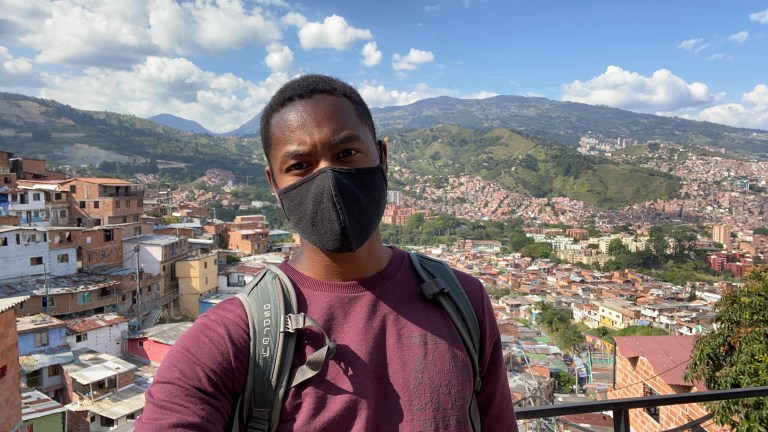
I spent three or four hours in Camuna 13, walking around searching for my favorite street murals or sitting down having a drink watching rappers serenade audiences with some bass-heavy Latin beats. I felt that I could’ve stayed much longer too, but heat and fatigue left me ready for a big meal before heading home. It’s also possible to hire a tour guide. They’ll provide history lessons while showing you even more hidden gems in the area. If I were to revisit Medellin, I would undoubtedly hire a guide and explore Camuna 13 again.
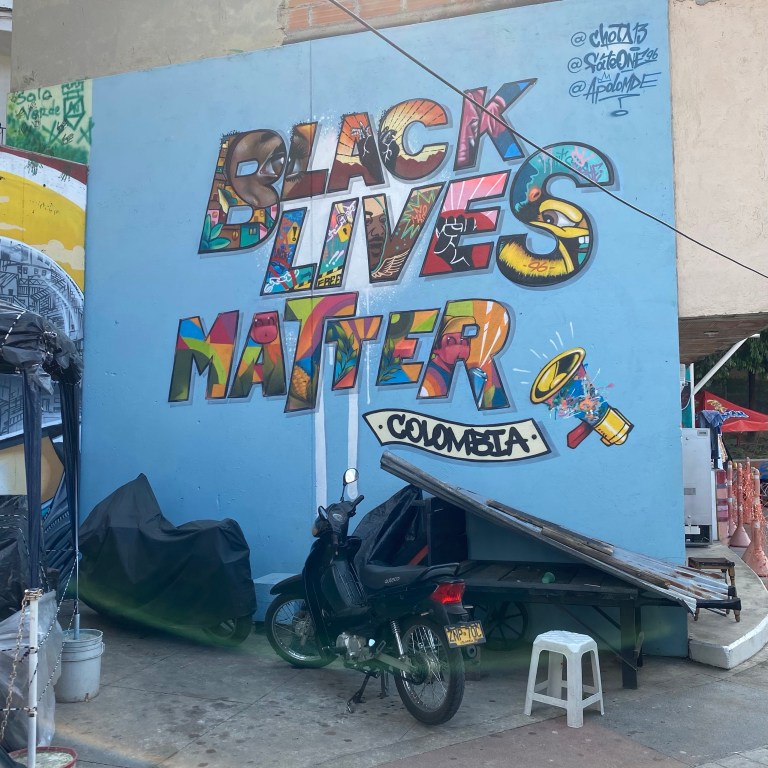
New friends and epic hikes
For my second week in Medellin, I googled some things to do and discovered the Botanical Garden, basically a large nature park in El Centro close to the university and metro station. This was a refreshingly peaceful little adventure where I could forget that I was a foreigner and just stroll through this massive park and take in all the nature. The Botanical Garden has a lake, some forestry, a park, a butterfly house, live events, and a bunch of wildlife (mainly giant iguanas).
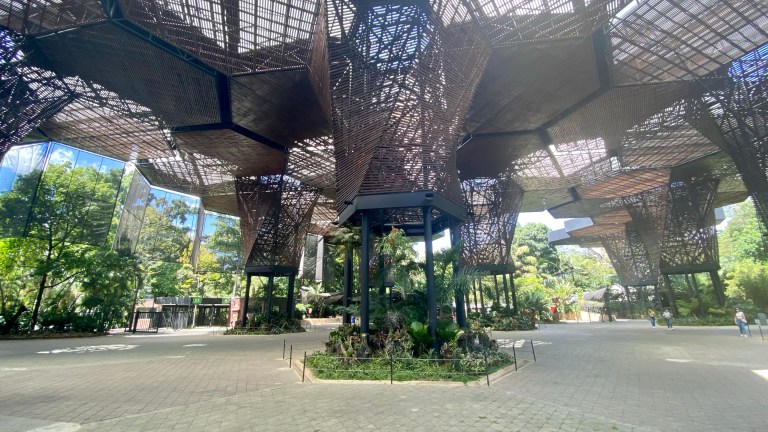

I spent most of the day at the Botanical Garden, taking in all the nature and unique architecture. I even spent an hour just sitting under a tree in the park, reading my Kindle. The butterfly house looked really cool, but it required a ticket and a tour guide.

On my way out of the garden, I was taking some pictures, and a guy walked up to me and asked if I wanted my photo taken. I told him I was good, I had my selfie stick after all, but we ended up sparking a conversation that led to me going back through the entire park again with him this time. He was bilingual, so it was super refreshing to talk to someone in English, and he was around my age. We became quick friends, and he’d end up being my adventure buddy for the rest of the month.
Medellin is known for its hikes that range in difficulty. None of them take long to get to either. The city has large nature parks peppered throughout, and some even have rivers and waterfalls.
The first hike me and my new friend went on was somewhat far out and up to one of the mountains to the east of the city Bello. It required us to take the metro to Santo Domingo station and take a long cable car ride up the mountain and over acres of a forest canopy. One observation I had on the cable car ride was just how remote some people were living up these hills, to the point where there were no more roads. I wondered how often they actually made the trip down the mountain into the city for supplies. For the most part, they must’ve been pretty self-sufficient.

Parque Arvi, the first hike we did together, was actually a massive ecological park with tons to do. You can rent bikes, horses, stay in hotels, camp, or just do a lot of walking. We walked a few miles along a road to an area with a long river and some places to camp. Then we took a backwoods route aiming toward Piedras Blancas. However, we got kind of lost but stumbled upon a really cool park nearby, which also had camping and a restaurant, hotel, and museum.
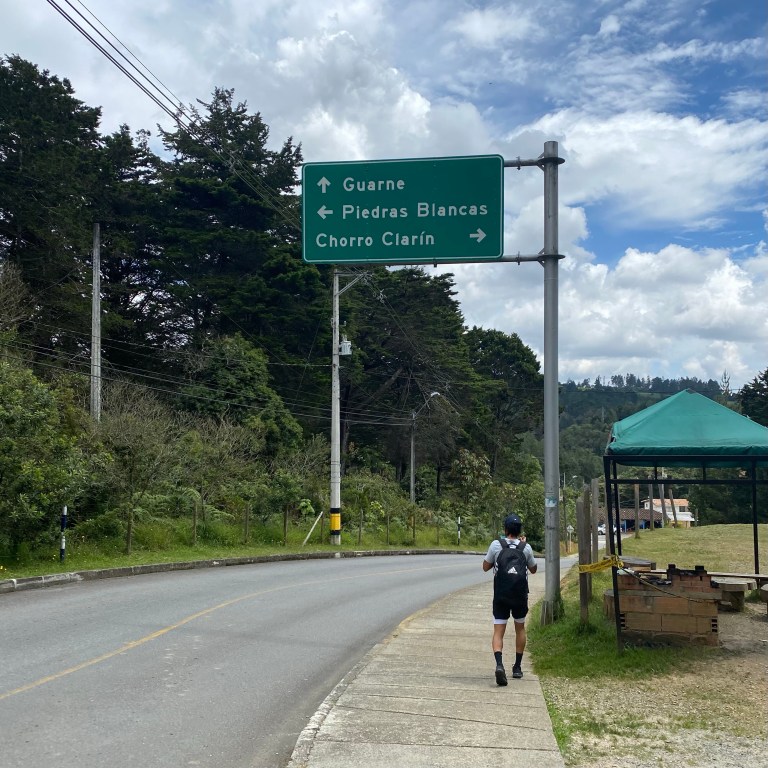
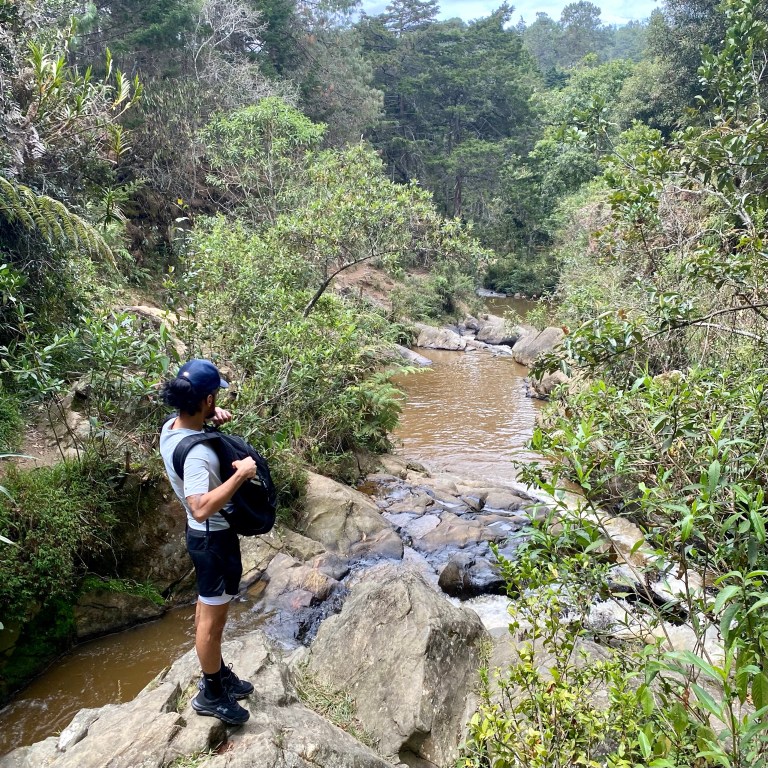
The following weekend we did a hike in the neighborhood Itagui called the Hill of Three Crosses (Cerro de Las Tres Crcues). This one was no joke. It’s basically a 45-minute hike up a massive hill the entire time. Paired with the heat, it was quite the struggle. At the top of the hill are the three crosses that are the hike’s namesake, plus there’s an outdoor gym and some small restaurants where you can grab some fresh fruit drinks. Reaching the top is absolutely worth the effort.


And the weekend after that, we hit peak adrenaline junky. We decided to do a quick hike followed by some paragliding. The hike was a short one called Ecoparque Mirador Cerro El Picacho which offered panoramic views of Medellin and Bello. After the hike, my buddy talked me into taking a bus further up the mountain to a paragliding zone called Paraglide Medellin, where several companies are offering the same paragliding adventure, more or less.
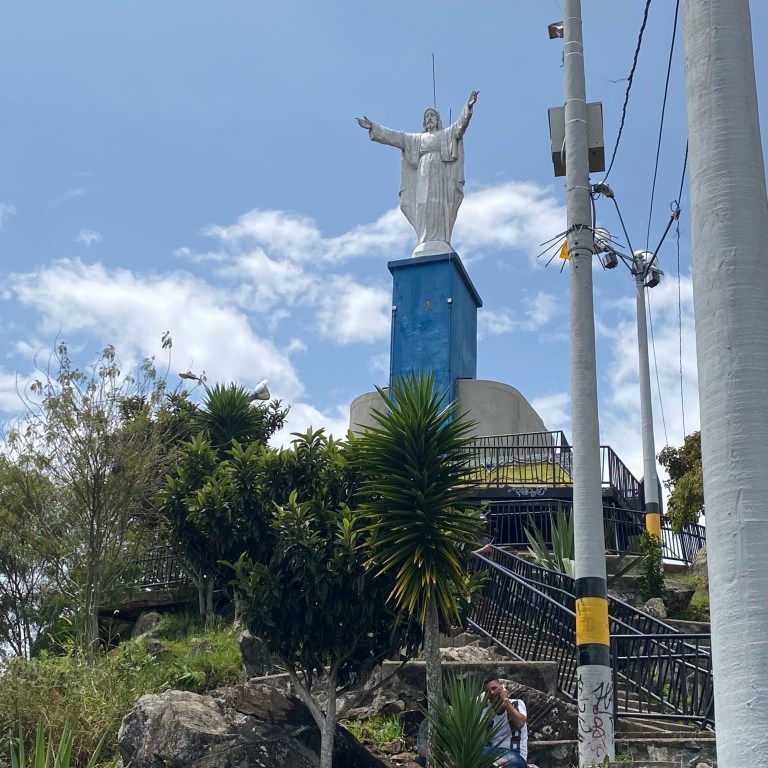

Paragliding was absolutely a peak experience in Medellin, something I’ve never done before. Our paragliding guide basically rode airstreams increasingly higher into the sky, offering us the ultimate view of Medellin and surrounding areas. At one point, my guide asked if I wanted to do some tricks, but I declined. I already experienced a series of cold sweats and heart palpitations whenever I looked down and realized how high up we were. Before embarking, I had already seen some of the tricks they performed, and I knew I just couldn’t handle it at that time. Maybe next time.
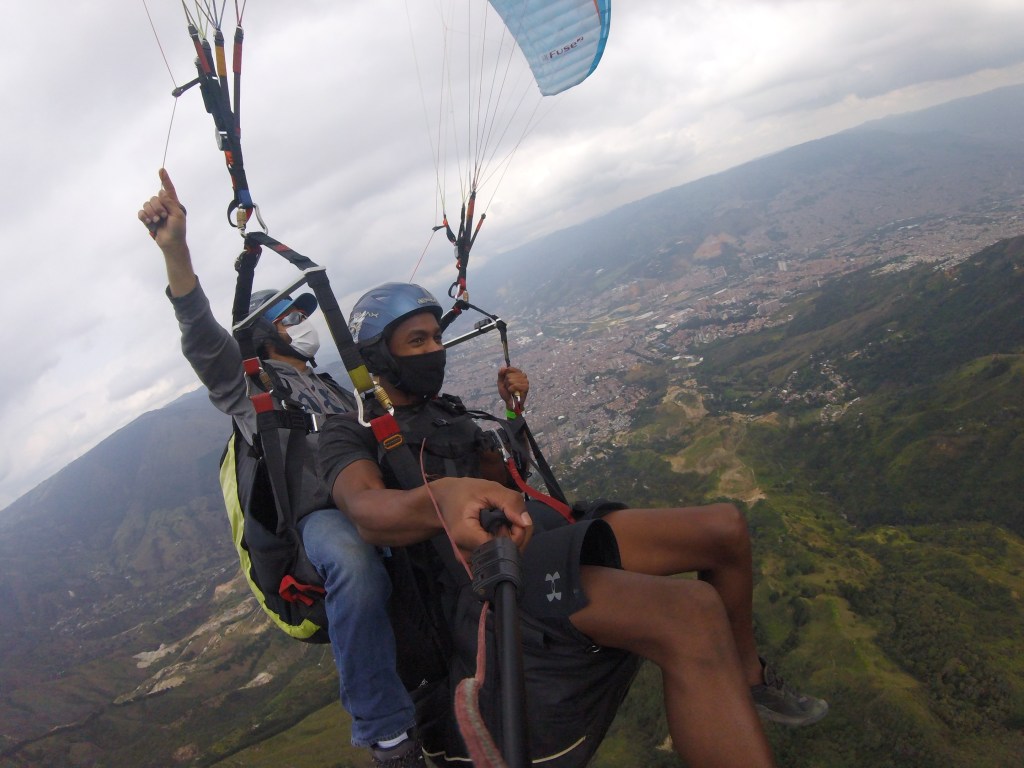

Surprisingly, the next day we were still up for some epic adventures and decided to make the obligatory journey to Guatape, a colorful village situated next to a large lagoon and a massive, oddly shaped rock. So early Saturday morning we took a bus two hours through country-land to Guatape.
Guatape
The ride to Guatape was beautiful itself. We passed through largely forested hills and small towns, and as we neared Guatape, we started seeing massive homes built on farmland. I learned later that Pablos Escobar actually owned a mansion out in these lands once. At some point, it occurred to me that the land surrounding Guatape would be perfect for retirement.
Our bus finally dropped us off at a little restaurant at the base of some stairs that led to La Piedra, the iconic, oddly shaped rock that is the main tourist attraction here. With legs still sore from yesterday, we made our way up this steep set of stairs, leading to the parking lot and gift shop area for La Piedra.
At this spot, it was clear to see just how massive the rock was, and it was possible to see the switchback staircase that tourists take up to the top. We were also afforded some pretty amazing views of the lagoon and surrounding countryside. We knew the view up top would be better, so we eventually proceeded to the switchbacks. And the switchbacks were grueling indeed. It’s comprised of 649 steps and took about 30 sweaty minutes to reach the top. Along the way, tourists could be seen taking much-needed breaks and laughing at how difficult the walk up was. All in good nature though. Realistically, anyone could do these stairs. Older people and children were doing it.
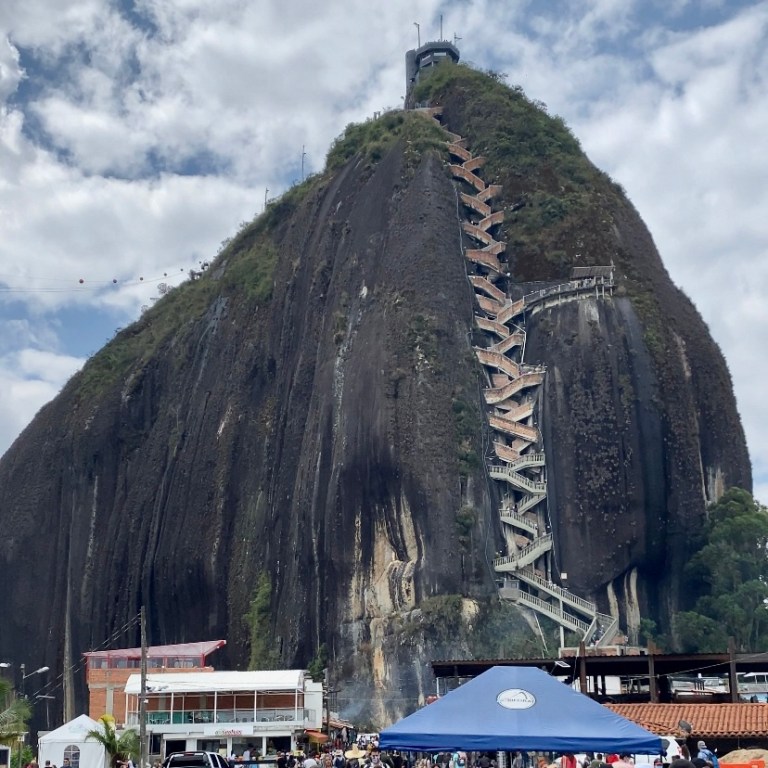
Making it to the top of La Piedra was a gratifying feeling. At the top were more restaurants and gift shops and a lookout tower with the best views. We hung out up top for another 30-minutes or so, eating, taking pictures, and looking out at the incredible panoramic views of the entire countryside for miles. Below in the lagoon, we could see people on speedboats, jetskis, and cruises.

After La Piedra, we caught a shuttle bus to the actual town of Guatape. Upon arrival, there’s a small marina next to the lake, with dozens of water activity vendors. My buddy had wanted to ride jetskis once we got there, so I let him do that while I went and looked for an ATM. While searching for an ATM, I also did some looking around at the quaint little town. Immediately I was struck by some of the vibrantly colored buildings lining the super narrow streets. None of the buildings exceeded two or three stories. I ended up finding a soccer field where an adult recreational team was playing and watched that for a few minutes. Eventually, I found what I think was the only ATM in the town, pulled out some cash, bought a beer, and hung out in the marina until my friend returned.

Once we were reunited, we explored through the city, weaving in and out of different streets and alleyways. Although there were what seemed like hundreds of unique and colorful little shops, we didn’t go into any of them and instead focused on the outdoors and finding streets that weren’t so filled with tourists.

One interesting (and somewhat refreshing) thing about Guatape was that it was probably one of the most touristy places to visit in Colombia. Because of this, it actually made me feel more comfortable than I had felt since arriving in Colombia. In Medellin, it was very rare that I’d see non-locals, so it was nice to just be a tourist in peace.

Our time spent in Guatape was mainly going down different streets and viewing the architecture. We managed to find areas that were completely void of tourists, including some tranquil, empty places near the water where we enjoyed nature a bit. Toward the end, I grabbed some food and another beer before deciding to catch a bus home late in the evening.

Moving to Envigado
My birthday was the weekend after I went to Guatape, and it was also the weekend I’d be moving into my next Airbnb. I chose a place south of Medellin called Envigado, which I later learned wasn’t technically in Medellin. While Envigado is connected to Medellin, they are considered two separate cities. This is also the case with a city called Bello just north of Medellin.
Envigado was much quieter and more residential than the bustling expat hotspot of El Poblado, Medellin, where I was previously. My Airbnb was an older apartment complex, with my room being next to a large family that owned the two neighboring rooms next to me. The host spoke next to no English, so it was an experience having her show me around the apartment and try to do the whole introductory thing. She ended up giving me a giant avocado as a housewarming gift, and it was perfect and delicious.

For better or worse, I didn’t end up doing much touristy stuff during my month in Envigado. One reason was just the general exhaustion from the crazy active first month I had with my new friend. After Guatape, he had actually ended up heading out into the mountains where he’d be staying for a month to do some fasting. Also, there was a solid two weeks of harsh rain and lightning storms that kept me inside. There was even a 5.5 earthquake that occurred at one point, which was wild. But overall, since I’m somewhat of a homebody, I took this as an opportunity to recharge a bit.
However, I made frequent trips to a nearby park to work out at one of the many outdoor gyms in Medellin and surrounding areas. Also, I ended up meeting another friend (who was actually a friend-of-a-friend from Mexico), and we explored the nightlife a bit. Since she’s a DJ, she was on the prowl for a nightclub where she might be able to play a free slot.
The first night we met up was in Parque Lleras, where the majority of good clubs were. She was also with a couple of friends. We all four did some eating, drinking, and searching for a club playing some good electronic music, and we did end up finding a cool place toward the end of the night. It felt a little sketchy given COVID, but with the semi-outdoor setup and the fact that some people (including us) were wearing masks, I eventually settled in.
The next day we discovered an event at another club where a pretty famous DJ named Lilly Palmer would be playing. The venue was hard to find, but the night was fantastic. Lots of underground rave feels; Colombian’s definitely know how to party. Again, a little sketchy with the COVID situation, but the club itself was pretty good at making sure people were hygienic, and the venue had an open roof.
A city’s nightlife is always something I like to experience when traveling, so I’m pleased I got to experience that in Colombia. But, unfortunately, that was pretty much the one-and-only weekend I partook.
Final month in Colombia
As I mentioned before, my month in Envigado was mainly uneventful due to heavy rainstorms and just feeling overall exhausted from the month before. March, however, was a bit more eventful as the weather lightened up a bit, and I felt more motivated to do some touristy stuff.
By mid-March, I had moved into my final Airbnb located just north of Laureles, Medellin, in a neighborhood called Calazans. I wasn’t actually too impressed with the host’s photos posted on the app listing, but reviews mentioned that it was a nice place. And wow, once I got there, it was the first time I’ve seen the reality of an Airbnb be better than the photos. The view was absolutely spectacular, the best I’d had since arriving in Colombia. It was in a pretty quiet local area as well and felt very authentic.

For my final month in this new location, I did some exploring of the surrounding area. I even visited one of the massive malls in this part of town. I reunited with my original adventure buddy from the beginning of the month. He was making a visit to Medellin again after spending some time fasting in the mountains. He was planning to head out for another month at the end of the weekend. We spent some time eating and walking around Atanasio Girardot Stadium, where all of the big futbol games happen, then got caught in a massive rainstorm.

This area was also pretty close to the tattoo studio I had been frequenting over the last few months. So I went and got a couple more tattoos from the artist I had befriended. I also frequented another outdoor gym I found in the area. And during my second to last full weekend in Colombia, I flew off to Cartagena, a super popular coastal town situated right on the Caribbean Sea in northern Colombia.
Cartagena
For my final big tourist adventure, I flew off searching for warm weather and beaches in the beautiful Cartagena. It’s known as “the Miami of Colombia” because of its long coastline of high-rise hotels along the Caribbean waters. Cartagena is known for being one of the earliest towns settled by Spanish Conquistadors in 1533 during the colonial era. It was an essential and strategic port for shipping enslaved Africans and offered good protection against pirate attacks. Old and colorful Spanish-style colonial buildings in Old City are juxtaposed against a backdrop of modern hotels over the bay.

I spent four nights in Cartagena for the weekend. The hotel I had wanted in the Old City district didn’t have my reservation for some reason, so they upgraded me to one of the high-rise hotels across the bay with all-inclusive access, no additional charge. No complaints there. Since I flew in late in the evening, I spent my first night watching Netflix. The next day I set out to explore Old City and the neighboring Getsemani district.
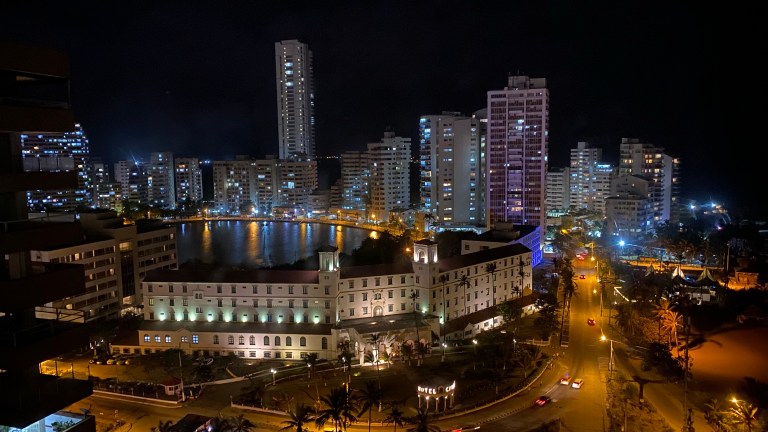
As its name suggests, Old City is the original colonial settlement with striking colors primarily in yellow, oranges, and reds. There are plenty of old Spanish-style buildings, statues of Spanish explorers, shops, and restaurants abound, and locals selling tourists everything under the sun. Large groups of Afro-Caribbean women wearing traditional sundresses can be seen selling fruits and taking pictures with tourists. You can walk along the old fortress walls that protected the city with cannons against pirates.

Getsemani is a slightly less touristy district just south of Old City, which many refer to as the art district. Colorful murals can be found down streets and alleyways. This area seemed a lot more youthful too, as most of the trendier-looking bars were here, plus all of the art gave it a hipster vibe. I spent a lot of time in Getsemani at night, where I watched street performers and went bar-hopping. Things started getting frantic around 12am as police began clearing some of the more populated streets, probably due to COVID precautions.


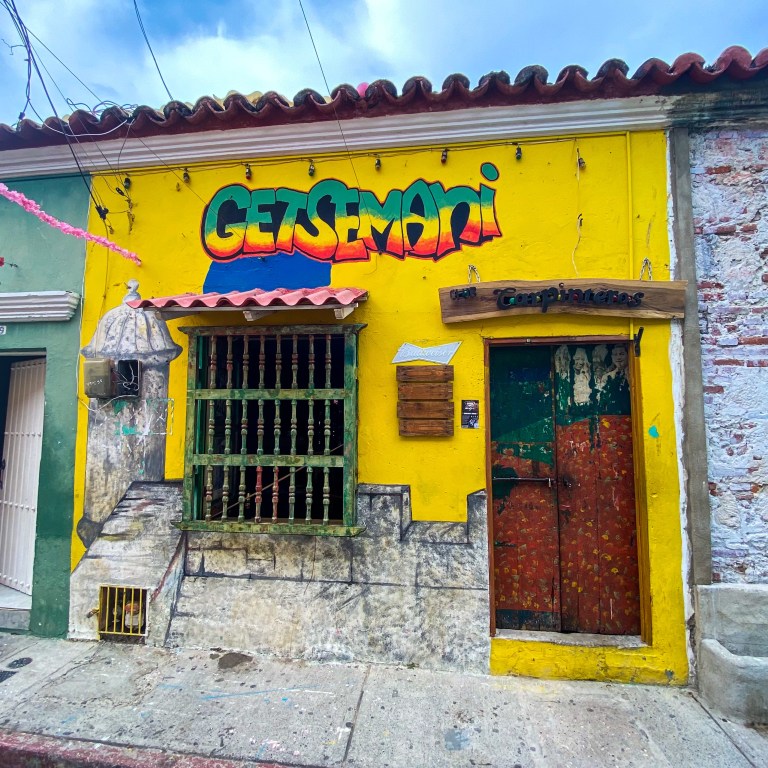
The next day I dedicated myself to chilling on the beach. I rented a private umbrella and drank and ate for a few hours, people-watching on the beach. I caught a super nice sunset and watched kiteboarders take advantage of the wind. A nearby beach club started playing some techno, so I went over there and danced for a bit. At night I had dinner at my hotel and took advantage of the open bar.

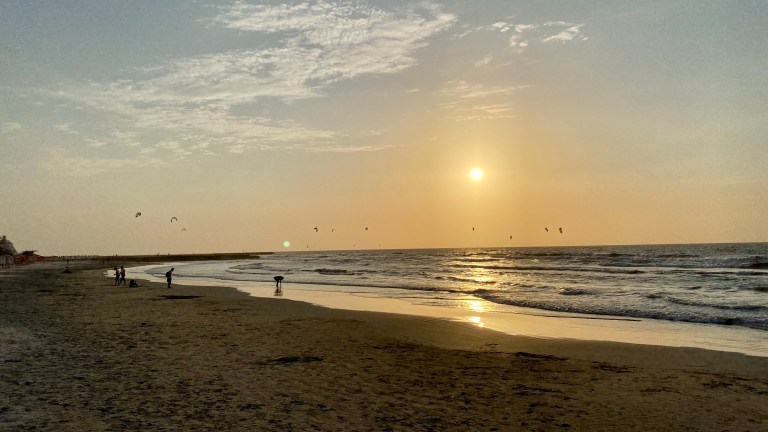
Although I had planned to fly out that Monday, I arrived at the airport too late and missed my flight. I had to reschedule for the next day and took the remainder of Monday off work to track down a new Airbnb to stay in that night. Luckily I got a last-minute booking in a nice room in Getsemani. I almost considered just staying the rest of the week, which would’ve been easy, but I decided not to since I was already paying for an Airbnb back in Medellin.
Saying goodbye to Colombia
For my last full weekend in Colombia, I decided to do a quick circuit of all the little landmarks I had skipped out on before. One such landmark was the grave of Pablo Escobar, who most know, ran a massive drug and political campaign in Medellin back in the ’70s. Due to the popularity of the Netflix show Narcos, many tourists see his grave as a “dark tourism” must-see.
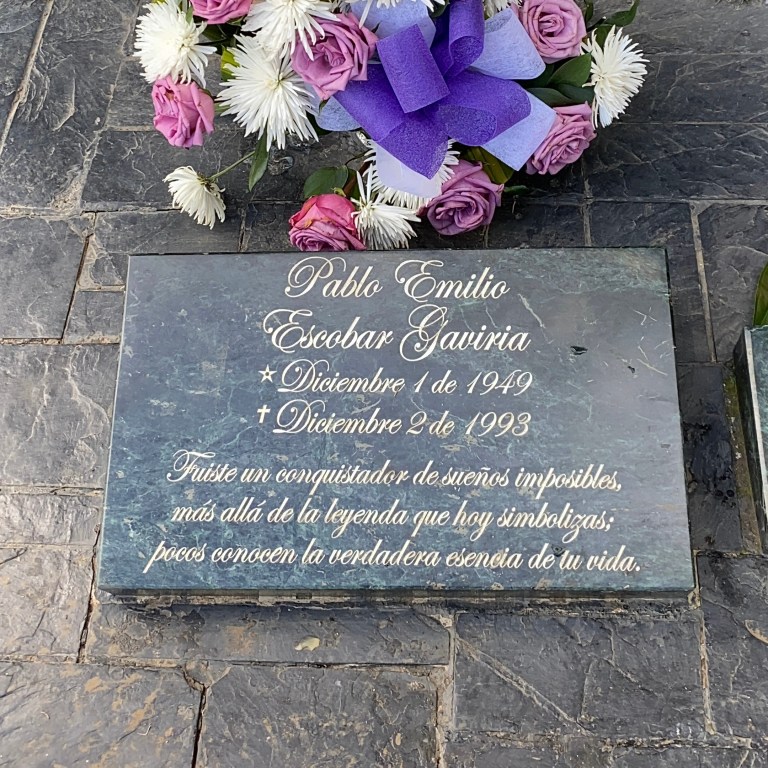
Unfortunately, I learned that the locals aren’t thrilled with this, as Pablo Escobar wasn’t nearly the celebrity foreigners (Americans) make him out to be. After all, he caused a lot of violence, death and destruction of Colombia’s international image. I suspect many older Colombians would like to put that history behind them. This is also the same sentiment that has spurred Medellin’s staggeringly rapid changes toward more tourist friendliness. Still, I had wanted to visit the grave out of curiosity and the fact that my cousin wanted a picture…
After visiting Escobar’s grave, I headed to El Centro for the rest of the day. I checked out the Botero Plaza museum honoring the famous Colombia artist Fernando Botero. I also walked around and visited a few other notable monuments. Due to a recent COVID curfew, the streets were pretty bare, though.

Heading back to the States
On April 16th, it was time to head back to the States. First, however, was a planned trip back to Playa Del Carmen, Mexico for a week to have a little vacation and visit old friends. I couchsurfed at a friend’s place for the week, sleeping outside on the hammock most nights and getting eaten by mosquitos. I hit up my old favorite spots and had a few nights out with friends. The weather was much hotter than when I was there a few months prior, and people seemed much more relaxed about COVID precautions. It was a great little vacation, though.
My next stop on my way back to my hometown of Portland was to visit a friend in Oklahoma for a weekend. He and his girlfriend showed me around Oklahoma City and his massive property in the countryside.
On Sunday of that weekend, I then flew to Austin, Texas to visit my cousin. I stayed at his house the entire week, just working remotely from his apartment. Surprisingly, it rained a lot while I was there, so I didn’t explore Austin much. I had a wild night out on the famous 6th Street though and went to a comedy club near there. Mostly though, my cousin and I just stayed inside and played video games like old times.
The following weekend on May 2nd is when I finally arrived home in Portland, Oregon.
Big takeaways from being a digital nomad in Medellin, Colombia
Just as I had read on the internet before booking my trip, Medellin is a perfect place to be a digital nomad. It’s a very well-developed city with solid infrastructure and everything you need for an extended stay. It would’ve been effortless for me to have spent a year there. The cost of living is about a third of the cost, often less, than the major cities in the U.S.
People in Medellin are mostly friendly. I never really had a bad run-in with anyone. The language barrier was probably the most significant obstacle. It was somewhat rare to find English speakers, especially outside of the expat-friendly Poblado area.
Before heading to Colombia, a lot of people expressed concern over my safety there. Shows like Narcos have really instilled people with the impression that Colombia is still a drug nation with gangs prowling the streets everywhere. That is far from the truth. While there are definitely some dangerous neighborhoods, I personally felt no danger in the areas I was in. In fact, I felt more in danger walking down a particular street in Austin, Texas than I did my entire three months in Colombia.
For those who enjoy nature, Medellin is the perfect blend of nature and urban. Massive green spaces and city parks are everywhere. Colombian’s really like their fitness too, and there are free outdoor gyms everywhere too. One thing I did struggle to find though were good vegetarian restaurants. They exist but are few and far between. But if you’re a fan of fruit, Colombia’s position near the equator makes for some fantastic options of the tropical variety. Medellin had some of the biggest mangos, bananas, and avocados I have ever seen, all for incredibly cheap, and they were delicious.
I was somewhat surprised to see that Colombia has a sizable Black/African population, but it makes sense given how northern South America was a target of the slave trade. Honestly, it made me feel more comfortable there as an African-American myself. In fact, many locals in Colombia mistook me for Afro-Colombian, that is until they heard me speak.
Overall, Medellin was a peak life experience for me, and I plan on going back at some point in my life. If you have any questions about visiting Medellin, feel free to message me on my contact page!

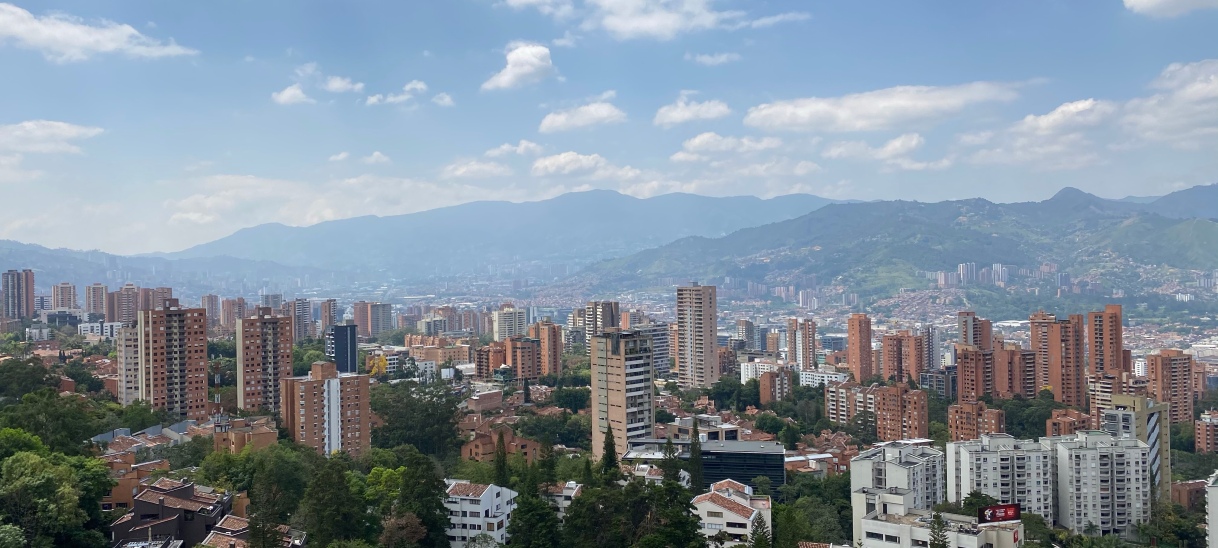

Digital nomads usually destroy the local culture and run up prices for the locals because you idiots are willing to pay high prices for everything. So do this all a favor and stay in the United States and be a good liberal and stop wasting carbon on your flights around the world
LikeLike
Hey thanks for commenting — this is a completely valid take and I agree that there are many downsides to the digital nomad lifestyle and tourism in general. I hope that through education and research on the localities they are visiting, digital nomads can reduce the footprint they have on the local culture and economies. Many of the countries visited by digital nomads have economies solely reliant on tourism and are practically begging us to come over. In that sense I am happy to contribute to the local economies, but I want to make sure I’m doing it with the average citizen in mind. So thank you for bringing up these good points.
I don’t think it’s fair to tell me to stay home and not explore the world. Especially as a Black man with slightly less privilege in my home country, I would hate to waste the privilege that I have to explore the world and learn about other cultures. I think that travel helps foster new perspectives, which ultimately leads to compassion for people unlike ourselves. I’d also like to point out that the U.S. isn’t the only source of digital nomads. During my travels I’ve met digital nomads from all over the world, with different skin colors, languages, and other cultural norms. But we all came together under a passion for travel and new experiences. Some of the friends I made in my travels were locals that were happy to show me the way. I hope that locals in the countries frequently visited by tourists get the chance to live out their dreams as well.
LikeLike